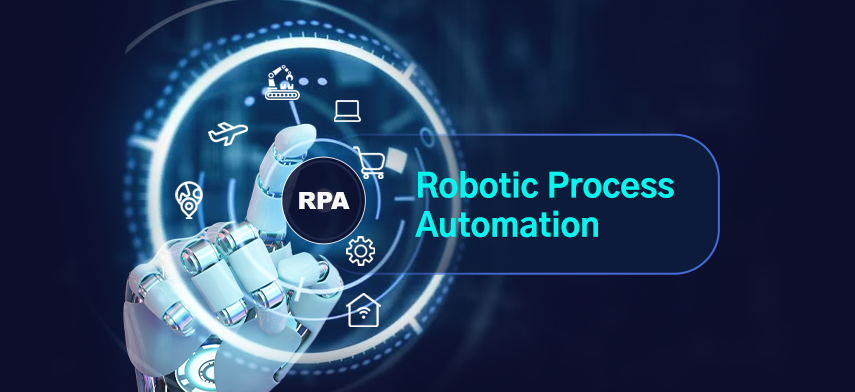
Mythbuster: There aren’t exactly any physical robotics involved in RPA.
What is RPA?
RPA involves the use of virtual robotics created on automation software to carry out sets of instructions on a computer. These RPA virtual robots (bots) are capable of repeating human-computer interaction tasks assigned to them. They can also carry out a ton of error-free tasks on voluminous data and at high speed (a difficult task for humans).
Benefits of RPA
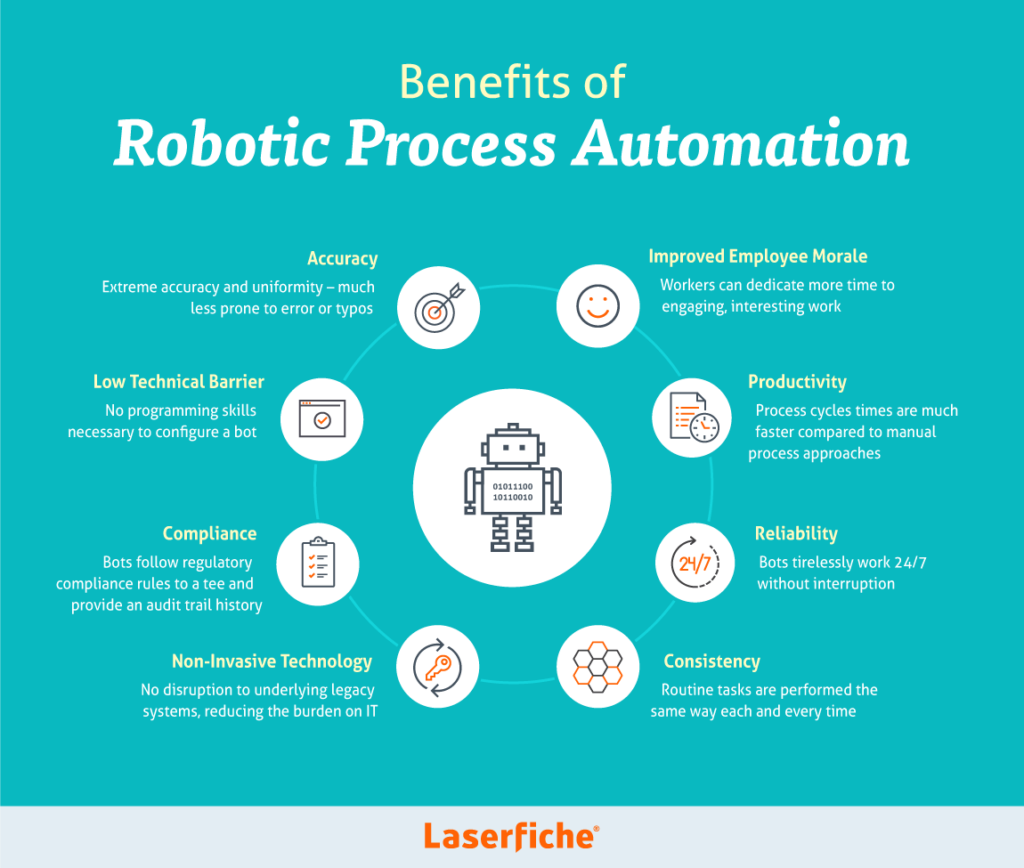
- The accuracy and precision in the quality of work that this brings in, post the automation.
- Minimization of errors as the whole process is completely automated, hence cutting down the chances of human errors.
- Process monitoring to the lowest level possible.
- Each action can be recorded, analyzed, and then optimized for better performance in future executions.
- Auditing, reporting can be achieved by this with the utmost ease.
- Software compliance can also be met with RPA based implementations.
- Reduced human intervention, and when needed necessary Human Tasks are created.
- In the long run, the built applications can be modified to form libraries for futuristic development.
- Completely Scalable and Flexible.
- Limited to work only on the front-end avoiding complexity, and hence integrations are to be considered until UIs – hence lesser time to bring an RPA based solution UP and Running!
- Reduced risk of errors, mishaps and etc.
- Availability – 24 x 7 a week, 365 days a year guaranteed.
- Higher speed and throughput.
- Absolutely no IT support is required as these Robotic Process Automation software can auto-feed the steps to check on what’s going wrong in Security.
- Possibility of continuous learning and improvement wherever required.
- Can maintain its Disaster recovery site itself for its own use.
- Brings down operational challenges to zero as these are completely manageable locally.
- Sensitive data can be processed by RPA software robots under strict surveillance, thus hiding these details from humans.
- Ability to route work based on the load that a single unit of RPA software robot can handle.
Use Cases of RPA
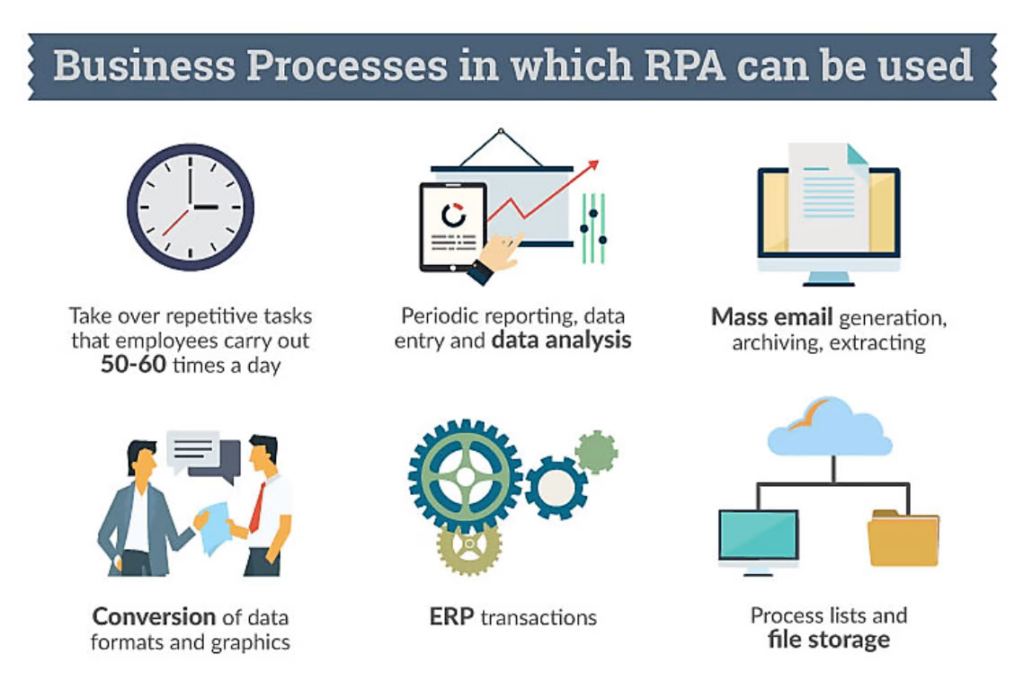
With the help of Robotic process automation, processes are mapped out and those works are done by following these processes. Those tasks which before needed human touch now can be expedited with RPA system. This concept has been able to make tasks achieving more easily. The tasks are also done in a more manageable manner with the help of a Robotic process automation system. Employees now do not have to do a boring repetitive task anymore which makes them more interested and focused on tasks which are more stimulating and also generate revenue. When systems do not know how to sync with dynamics then it requires entry if data twice into the CRM system. This is done so that everything can be tracked. With the help of RPA this problem can be solved. Robotic process automation will delete the unnecessary task of double-entry of data a bad creates an agile and dynamic transfer of information among the systems. Now with the help of RPA system, the documents in the Enterprise resource planning (ERP) system can be read from without any problem. In case of workflow conditions, you will be able to measure performance and aptitude of human beings. This is a way better process than baseline or KPIs. If a workflow need to do some human interventions so that it can see how someone works with efficiency then it is a helpful process. With the help of RPA you will also be able to gain details about your team. If a particular business location is filled with workload then you will also be able to route work someplace else.
Breach of data is an unfortunate incident and if such leaks occur then businesses get almost ruined. Since the data are stored in a central repository if you are using RPA, it ensures that the setting of accessibility is done by the employee. This makes sure that the right person will handle the data that is linked to their workflow otherwise the non-required data are encrypted thus safe.
In the manufacturing and health care industry you will need to store documents for more than 5 to 7 years. Now with the advent of e-signature and also digital filling, you will be able to store important documents properly and safely. There will be physical damage or loss to them. Documents are also sometime stored in files and kept in cabinets that are often not found. These problems can be solved with the robotics process automation system. This system stores information and it can also remember and transfer this information very easily. This makes you auditable and tax ready anytime.
Which sector can RPA be applied?
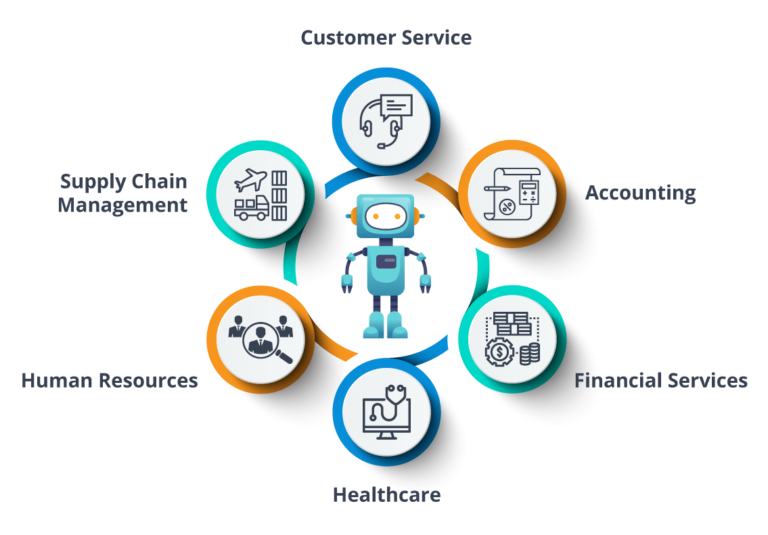
Common areas that have seen success include payroll, accounts payable, employee action, and customer service. RPA can be used in Sales & Distribution (SD), Human Capital Management (HCM), and Supply Chain (SCM)
1. Telecommunications
Robotic Process Automation can be applied to most of the processes within the Telecommunications domain, but the most feasible scenarios where these solutions can flourish are the Consolidation of client phone systems, take backup information from the client systems, Uploading the necessary data on a regular basis for the clients to take advantage from, check for the competitor pricing on regular intervals, collecting details on the phone manufacturing information and the like.
This doesn’t stop here, over the years to come to these use cases within the telecommunications domain itself will grow leaps and bounds creating enough opportunities for technologies like Robotic Process Automation to make the necessary automation frameworks.
- Banking
Robotic Process Automation can be applied to most of the processes within the Banking domain, but the most feasible scenarios where these solutions can mark a difference are the data validations, data migration between applications, customer account management, report creation, comparing mortgage values across cities, form filling, financial claims processing, updating loan data and backing up teller receipts.
This doesn’t stop here at all, the solutions that can be applied in any of the scenarios as explained earlier can also be extended to implement into newer areas of the Banking domain. These will provide enough opportunities for technologies like Robotic Process Automation to flourish in the automation space.
- Insurance
Robotic Process Automation can be applied to most of the processes within the Insurance domain, but the most feasible scenarios are those where these solutions flourish – as like the scenarios mentioned here from the Insurance domain, to automate the administrative and customer service activities related to receiving, reviewing, analyzing and remitting claims.
This does not stop here at all and the use-cases that it can be applied to will grow on a scenario-to-scenario basis. Solutions provided to one scenario can make it possible to extend the automation to other areas where this can be achieved to go further. These will open up more opportunities for technologies like Robotic Process Automation to automate processes further deep into the domain space.
- Healthcare
Robotic Process Automation can be applied to most of the processes within the Healthcare domain as well, ranging from the patient registration processes to the patient data migration, patient data processing, reporting for doctors, medical bill processing, insurance data automation, and claim processing, triggering emails from medical billing systems, claim status and eligibility automation, and patient record storage.
This list does not stop here, once the Robotic Process Automation software robots are applied to do these tasks – down the future lane, the processes that are closely related to these would also be required to be automated thereby saving a lot of time. One of the best examples is the time taken earlier to share the reports for any of the medical examinations an individual goes through. That has decreased drastically by the latest processes being and if Robotic Process Automation is given a chance in this domain, then it can create miracles in the whole turnaround times.
- Finance
Robotic Process Automation can be applied to most of the processes within the Banking domain, but the most feasible scenarios where these solutions can mark a difference are the data validations, data migration between applications, customer account management, report creation, comparing mortgage values across cities, form filling, financial claims processing, updating loan data and backing up teller receipts.
This doesn’t stop here at all, the solutions that can be applied in any of the scenarios as explained earlier can also be extended to implement into newer areas of the Banking domain. These will provide enough opportunities for technologies like Robotic Process Automation to flourish in the automation space.
- Retail
Robotic Process Automation can be applied to most of the processes within the Retail domain as well, ranging from extracting product data from manufacturer’s websites, automatic online inventory updating, importing website and email sales. This just doesn’t stop there, but the solutions that are applied in the scenarios explained will definitely require to be extended for futuristic automation and hence the automation can reach an end-to-end phase.
- Manufacturing
Robotic Process Automation can be applied to most of the processes and scenarios within the Manufacturing domain as well, ranging from existing ERP Automation, automation of logistics data, data monitoring, and product pricing comparisons. Not just that, the scenarios that are automated will require the other scenarios that are intertwined with them also to be automated for futuristic automation requirements and needs. Hence Robotic Process Automation tools and software can create wonders once implemented and then the automation goes almost to the levels of end to end.
- IT
Robotic Process Automation can also be applied in the IT industry as well. Shocked to hear that? No, there are enough jobs and scenarios that are supposed to be done just the same way each and every other single day. Have you ever tested any regression tests for an application, which are the same steps to be executed for each and every build of an application? Hence all such scenarios can be fully automated with the help of Robotic Process Automation and also not just those, but the other feasible options as like the others can also be considered – Hardware and software testing for functional, load, and mobile performance.
Categories
- 3D Modelling (1)
- Artificial Intelligence (1)
- Business (1)
- Graphics (1)
- iOT (1)
- Mobile App Development (1)
- Robotics (3)
- Uncategorized (1)
Recent Posts
-
Robotics Africa Grooms Champions
Feb 22, 2023
Why Register your Child for VirtualMar 27, 2023
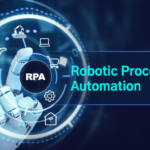 Why Skillup on Robotics Process Automation
Why Skillup on Robotics Process AutomationNov 21, 2022
 One Month Artificial Intelligence(AI) Training
One Month Artificial Intelligence(AI) TrainingMay 19, 2022
Newsletter
Get regular updates on data science, artificial intelligence, machine



